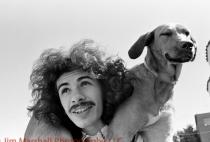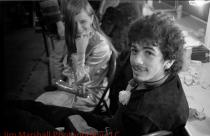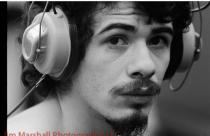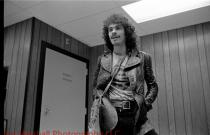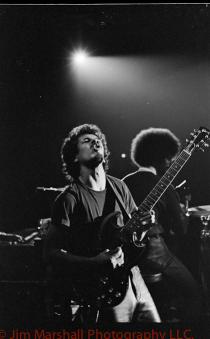“It’s time for people to realize that we are all mixed up inside. That is why there is so much diversity on my records. I can relate to so many cultures and I want that to be reflected in my music.” — Carlos Santana
Today’s blog continues our exploration of Jim’s work capturing the playing and passion of Carlos Santana, a true guitar original who has become synonomous with the early SF scene and who remains a catalyst for the ascendancy of “world music” onto the world’s stage. The passion, spirit and open-mindedness that Carlos brought to his music seemed to be present from the first time he picked up an instrument at age 5. He started on violin at the urging of his father, Jose, who was a renowned Mariachi violinist in Mexico, but Carlos gravitated to the guitar at 8 years old and never looked back.
As a musician who is widely credited with popularizing “world music,” it seems that Carlos always had big ears and the heart to match, you can hear it in his earliest work and you can see it in the joy captured in Jim’s photos that we have unearthed for you ... most of them published here for the first time. This quote offers a taste of Carlos’ world view, then and now: “The ’60s were a leap in human consciousness. Mahatma Gandhi, Malcolm X, Martin Luther King, Che Guevara, Mother Teresa, they led a revolution of conscience. The Beatles, The Doors, Jimi Hendrix created revolution and evolution themes. The music was like Dalí, with many colors and revolutionary ways. The youth of today must go there to find themselves.”
So how did Carlos Santana come to this realization? What were the early influences and struggles that helped form his mind, heart, music and world view? Here's a decent recap from his wikipedia page: “In San Francisco, [Carlos] got the chance to see his idols, most notably B.B. King, perform live. He was also introduced to a variety of new musical influences, including jazz and folk music, and witnessed the growing hippie movement centered in San Francisco in the 1960s. “After several years spent working as a dishwasher in a diner and busking for spare change, Santana decided to become a full-time musician. In 1966, he gained prominence by a series of accidental events all happening on the same day. Santana was a frequent spectator at Bill Graham’s Fillmore West. During a Sunday matinee show, Paul Butterfield was slated to perform there but was unable to do so as a result of being intoxicated. Bill Graham assembled an impromptu band of musicians he knew primarily through his connections with the Grateful Dead, Butterfield’s own band and Jefferson Airplane, but he had not yet picked all of the guitarists at the time. Santana’s manager, Stan Marcum, immediately suggested to Graham that Santana join the impromptu band and Graham assented.
“During the jam session, Santana’s guitar playing and solo gained the notice of both the audience and Graham. During the same year, Santana formed the Santana Blues Band, with fellow street musicians, David Brown and Gregg Rolie (bassist and keyboard player, respectively). “With their highly original blend of Latin-infused rock, jazz, blues, salsa, and African rhythms, the band (which quickly adopted their frontman's name, Santana) gained an immediate following on the San Francisco club circuit. The band’s early success, capped off by a memorable performance at Woodstock in 1969, led to him signing a recording contract with Columbia Records, then run by Clive Davis.”
Carlos the Conscience From Carlos’ official website a nice blurb on his humanitarian side: “The arc of Santana’s performing and recording career is complemented by a lifelong devotion to social activism and humanitarian causes. The Milagro Foundation, originally established by Carlos Santana and his family in 1998, has granted more than $5 million to non-profit programs supporting underserved children and youth in the areas of arts, education and health. Milagro means “miracle,” and the image of children as divine miracles of light and hope — gifts to our lives — is the inspiration behind its name.” In our next blog we will take an in-depth look at how Jim captured Carlos’ otherworldly guitar playing, both in the studio and on some of the world’s greatest stages. Until then, I’ll leave you with one more of Carlos’ apt observations, and one that Jim (not the world's most spiritual man) would certainly be able to agree with, at least in part: “If our history can challenge the next wave of musicians to keep moving and changing, to keep spiritually hungry and horny, that’s what it’s all about.”
- Jim Marshall Photography LLC Newsroom blog
- Log in to post comments
